第7章电子信息类专业英语(李白萍)
电子类专业英语

• 表示假设--姑且说 表示假设--姑且说 -ten.余下的数 The number left was not great, say, only ten.余下的数 目不大, 姑且说, 只有十个罢。 目不大, 姑且说, 只有十个罢。
• 表示大约
二. 课文翻译讲解
1、疑难词汇: 疑难词汇:
• vibrate : [‘vaibreit] 震动 , 使震动 , ( 情感上 ) vibrate: vaibreit] 震动, 使震动, 情感上) 被撼动 • Substance:[‘sʌbstəns] 物质,材料 Substance: s bstə 物质, • Amplify:[' mpli,fai]放大(声音等);增强 Amplify:['æmpli,fai]放大(声音等) mpli,fai]放大 • Transform:[tr ns fɔ:m] 改变,转换 Transform:[træns ns‘f 改变, • Continuous:[kən'tinjuəs]连续的,不断的 Continuous:[kən'tinjuəs]连续的 连续的, • discrete:[di'skri:t]分离的;不连接的 discrete:[di'skri:t]分离的 分离的; • Quantity:[‘kwɔntiti] 量,数量 Quantity: kw kwɔ • quantitative:['kwɔntitətiv]数量的,定量的 quantitative:['kwɔntitətiv]数量的 数量的,
• • • • • •
We will have the meeting in the classroom rather than in the great hall. 我们是在教室里开 不是在大厅里。 会,不是在大厅里。 She enjoys singing rather than dancing. 她 喜欢唱歌,而不喜欢跳舞。 喜欢唱歌,而不喜欢跳舞。 We should help him rather than he should help us. 是我们应该帮助他而不是他应该帮 助我们。 助我们。 I decided to write rather than (to) 我决定写信而不打电话。 telephone. 我决定写信而不打电话。 他是跑来的, He ran rather than walked. 他是跑来的,而 不是走来的。 不是走来的。 注意:这里rather 后用了walked walked, 注意:这里rather than 后用了walked,而没有 walk,表示客观事实,而不是主观愿望。 用walk,表示客观事实,而不是主观愿望。如果换成 walk,则作“宁愿……而不愿 ……”解。 walk,则作“宁愿 而不愿 解
电子信息专业英语要点总结

电子信息专业英语要点总结第一篇:电子信息专业英语要点总结重点词汇1.TDM——Time Division Multiplexing 时分复用FDM CDM 2.PCM——Pulse Code Modulation 脉冲编码调制3.PCI——Peripheral Component Interconnect 周边元件连接口4.IDE——Integrated Drive Electronics 集成驱动器电路5.AGP——Accelerated Graphic Port 加速图形接口B——Universal Serial Bus通用串行接口7.HDL——Hardware Description Language 硬件描述语言8.PLD——Programmable Logic Device 可编程逻辑器件 9.FPGA——Field Programmable Gate Array 现场可编程门阵列 10.ASIC——Application—Specific Integrated Circuit专用集成电路 11.DSP——Digital Signal Processor 数字信号处理器12.SoC——System-on-Chip 片上系统 13.Learnning curve 学习曲线14.IEEE——Institute of Electrical and Electrics Engineers 电气与电子工程师学会15.sample and hold circuit 采样与保持电路16.price/performance ratio 性能价格比 17.harvard architecture 哈佛结构 18.looping scheme 循环机制19.FFT——Fast Fourier transform 快速傅里叶变换 20.PCB——Printed Circuit Board 印刷电路板 21.SPS——Sample Per Second 每秒样本数 22.block diagram 方框图 23.Dolby Stereo 杜比立体声24.transmission bandwidth 传输带宽 25.signal-to-noise ratio 信噪比汉译英句子1.“信道”这个术语通常是指频分多址系统中的一个频率,时分多址系统中的一个时隙,码分多址系统中的一个代码或混合系统中的频率,时隙,代码中的某中组合。
电子信息类专业课中英文对照表

电子系统设计
Electronics System Design
电磁兼容理论ElectromaneticCompatibilityTheory
电子设计自动化
ElectronicsDesign Automation
检测与转换技术
Signal Detection and Conversion Technology
计算机网络
Computer Networks
电磁场与微波技术
Electromagnetic Fieldand MicrowaveTechnology
现代通信技术
Modern CommunicationsTechnology
DSP原理及应用
Principlesand Applicationsof DSP
现代通信网
Modern Communication Networks
计算机网络安全
Computer NetworksSecurity
光纤通信技术(双语)
Optical Fiber CommunicationTechnology
实践环节翻译
实践环节翻译
军训及新生入学教育
MilitarySkillsTraining andFreshmenEducation
现代信息处理技术
Modern Information ProcessingTechnology
语音信号处理
Speech SignalProcessing
虚拟仪器基础(双语)
FundamentalsofVirtual Instrument
Matlab语言及应用
Matlab Language and Application
电子信息专业英语整套课件完整版电子教案最全ppt整本书课件全套教学教程(最新)

上一页
返回
第三课 晶体管及其基本电路
现在,晶体管是电子技术中最重要的器件。它们不仅作为独立元件, 而且在集成电路微薄的硅片上可包含成千上万个晶体管
晶体管由3层半导体材料构成:一种类型的薄层在中间,两边分别是另 两种类型。可以有两种排列方式:N型在中间,P型在两边(PNP); P型在 中间,N型在两边(NPN )。中间层称为基极,两边外层分别称为发射 极和集电极(如图1-17所示)
电子信息是当今国内外发展最迅速、技术更新最快的工程领域之一, 电子信息专业英语对学习电子信息新知识和新技术起着非常重要的作 用。
下一页 返回
前言
本书是一本突出高等教育实用特点的电子信息专业英语教材,内容涉 及电工电子基础、仪器仪表使用、传感器技术、通信技术等方面,基 本覆盖了现代电子信息的各个领域,同时收录了一些电子信息新技术 领域发展前沿方面的文章(如太阳能、电子纸、蓝牙技术和3G等)。课 文内容丰富,题材广泛,通俗易懂,选择的文章实用性强并尽量保证 学生能利用已有专业知识理解课文内容。每课课后有词汇、注释、练 习及阅读等。在本书书后附有课文参考译文及部分练习参考答案,供 读者参考对照。另外,书后还附有电子专业词汇和科技英语阅读与翻 译技巧相关知识,供相关专业读者参考。
上一页 下一页 返回
前言
本书由王菲、施亚齐担任主编,并编写了第四、第五篇,董小琼编写 了第一篇,王俊清编写了第二篇,邹淑云编写了第三篇。
由于编者水平有限,时间仓促,书中难免有纰漏和不足之处,请尊敬 的教师、同学和广大学者批评指正。
上一页
返回
目录
电子信息类专业英语 李白萍编 第二版译文
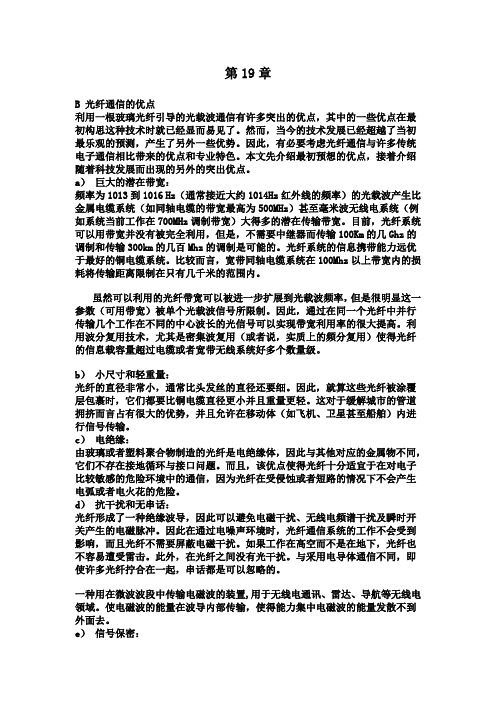
第19章B 光纤通信的优点利用一根玻璃光纤引导的光载波通信有许多突出的优点,其中的一些优点在最初构思这种技术时就已经显而易见了。
然而,当今的技术发展已经超越了当初最乐观的预测,产生了另外一些优势。
因此,有必要考虑光纤通信与许多传统电子通信相比带来的优点和专业特色。
本文先介绍最初预想的优点,接着介绍随着科技发展而出现的另外的突出优点。
a)巨大的潜在带宽:频率为1013到1016 Hz(通常接近大约1014Hz红外线的频率)的光载波产生比金属电缆系统(如同轴电缆的带宽最高为500MHz)甚至毫米波无线电系统(例如系统当前工作在700MHz调制带宽)大得多的潜在传输带宽。
目前,光纤系统可以用带宽并没有被完全利用,但是,不需要中继器而传输100Km的几Ghz的调制和传输300km的几百Mhz的调制是可能的。
光纤系统的信息携带能力远优于最好的铜电缆系统。
比较而言,宽带同轴电缆系统在100Mhz以上带宽内的损耗将传输距离限制在只有几千米的范围内。
虽然可以利用的光纤带宽可以被进一步扩展到光载波频率,但是很明显这一参数(可用带宽)被单个光载波信号所限制。
因此,通过在同一个光纤中并行传输几个工作在不同的中心波长的光信号可以实现带宽利用率的很大提高。
利用波分复用技术,尤其是密集波复用(或者说,实质上的频分复用)使得光纤的信息载容量超过电缆或者宽带无线系统好多个数量级。
b)小尺寸和轻重量:光纤的直径非常小,通常比头发丝的直径还要细。
因此,就算这些光纤被涂覆层包裹时,它们都要比铜电缆直径更小并且重量更轻。
这对于缓解城市的管道拥挤而言占有很大的优势,并且允许在移动体(如飞机、卫星甚至船舶)内进行信号传输。
c)电绝缘:由玻璃或者塑料聚合物制造的光纤是电绝缘体,因此与其他对应的金属物不同,它们不存在接地循环与接口问题。
而且,该优点使得光纤十分适宜于在对电子比较敏感的危险环境中的通信,因为光纤在受侵蚀或者短路的情况下不会产生电弧或者电火花的危险。
电子信息专业英语正式版

The Translation
原句
3、The frequency of a waveform can be determined by counting the number of centimeters, horizontally, in one cycle of the waveform and then multiplying it by the setting time/cm control.
4、For example, if the waveform is 2 cm long and the control is set at 1 ms/cm, the period would be 2 ms. The frequency can now be found from the formula: f=1/T=1/2 ms=500Hz.
重点词汇 frequency ['frikwənsi] n. 频率;频繁 centimeter ['sɛntə,mitɚ] n. [计量] 厘米;[计量] 公分 horizontally [,hɑrə'zɑntli] adv. 水平地;地平地 multiplying ['mʌltɪplaɪɪŋ] adj. 乘法的v. 乘;繁殖;增加
示波器是最重要的电子测试仪器之一。
The Translation
原句
2、It is widely used in the electronic industry for research and development, design work, trouble shooting and signal monitoring, manufacturing and production line testing, and many other applications where the observation of an electrical waveform is desired.
电子信息工程专业英语(第三版)词汇表

a portion of 一部分a variety of各种各样的a mass of 大量的AC abbr. Alternating Current 交流电accide ntal adj.意外的accumulator n.累加器acquisiti on n.获取,采集acquisition time 采集时间acquisition time 采集时间activate vt .激活active adj.有源的actuator n 致动器,执行器add-o n n.附件administration邮电管理局address vt.从事,忙于address gen erator 地址产生器address poin ter 地址指针addressing mode 寻址模式adjustme nt n 调整,调节ADSL abbr. Asymmetrical Digital Subscriber Loo非对称数字用户线adverse adj不利的,相反的AFG Arbitrary Function Generator 任意函数发生器aggregate v.聚集,合计AGP Accelerated Graphic Port 加速图形接口akin adj.同族的,类似的algorithm n.算法alias ing n.混叠现象alkali ne adj.碱性的all in all 总而言之all of a sudde n 突然allocate vt.分配allocate vt.分配allow for 虑及,体谅allow for 虑及,酌留alpha nu mericadj.包括文字与数字的alter v.改变alter native n .选择 ALU abbr Arithmetic Logic Unit 算术逻辑单元alumi nium n 岭铝ambie ntadj.周围的 n.周围环境an alogous adj.类似的 an cillary adj.辅助的,副的an guish n 痛苦,苦恼analogyn.类似,类推an gular freque ncy 角频率anno tati on n.标注,注角军antenna n.触角,天线anti-aliasing filter抗亍昆叠滤波器anti-aliasing filter 抗混叠滤波器applia nee n.用具,器具applia nee n.用具,器县applicati on in terface 应用程序接口approach n.方法appropriate adj.适当的approximati on n.近似(值)approximati on n.逼近,近似值archive vt.存档n.档案文件arena n.竞技场,舞台arena n.竞技场舞台arise from 由…引起;从…中产生arithmetic n算数array n.阵列,数组array n.数组,阵列artificial adj.不自然的as a consequenee 因此匕as always 照常as opposed to ..与...相反as yet到目前为止ASIC abbr. Application Specific Integrated Circuit专用集成电路ASIC Applicati on Specific In tegrated CircuitASIC Applicatio n-Specific I ntegrated Circuit^ 用集成电路assembler n 汇编器assembly Ian guage 汇编语言assig nment n.赋值ASSP abbr. Application Specific Standard Product专用标准器件ASSP Applicatio n-Specific Sta ndard Part专用标准器件assume vt 假定asynchronous adj.异步的asynchronous adj.异步的atte nu ator n.衰减器audiophile n.高保真音响爱好者auditorium n.会堂,礼堂auditory system 听觉系统automatic variable 自动变量automotive adj.汽车的AWG Arbitrary Waveform Ge nerator 任意波形发生器B(be) known as …称作......(be) capable of具备••…的能力(be) equivalerit to 相当于... ,等价于 ...(be) proportional to 与•…成比例back bias 反向偏压backplane n.背叛backside n.背部,后方bar graph条形图bargai n n.交易,协议,廉价品barrier n.隔板,势垒,阻挡层base station 基站base stati on 基站baseba nd n.基带baud n 波特be concerned with •对•…关心be encumbered with 为…•所累be mad e up of由…•组成be referred to as.... 被称作...be thought of as 被认为....beam splitter 分光镜behavioral syn thesis 行为综合ben eficial adj.有益的,受益的Bessel filter贝塞耳滤波器biased adj.加偏压的,有偏向的bill of materials 材料单BIOS abbr. Basic Input Output System基本输入输出系统bipolar adj.双极性的bit vector位向量bland adj.平淡的block diagram 方框图blow up 爆炸,放大blur v使…•模糊BNC bayo net neill-co ncelman 同轴电缆卡环形接头boast v.夸耀Bode plot伯德图bond n.接头Boolean variable 布尔变量boost n.升压,放大bootn.启动,引导,自举boot sector弓丨导扇区bootstran.引导程序pbootstraloader引导装入程序pbrake n.刹车branch instruction分支指令brief adj.短暂的bring up 捉出,引出browse v.浏览budget n.预算budget n.预算budgetary adj.预算的buffer n 缓冲器buffer r 1.缓冲器,缓冲区buildi ng block构件,模块built-in adj.内置的bulky adj.体积大的bulky adj谷量大的,体积大的bun chin.聚束ngbus in terface 总线接口bus in terface 总线接口by one ' s(own) bootstraps 通过自己的努力by way of 经由;作为Ccable n.电缆cable modem 线缆调制解调器cable TV 有线电视cache n.高速缓存CAD Computer Aided Desig n 计算机辅助设计calculable adj.可计算的,能预测的calculation-intensive algorithm 运算密集型算法camcorder n.便携式摄像机can did adj.非排演的,偷拍的capacitive adj.电容性的capacitor n.电容器capacity n.容量,电容capture v .记录,输入carrier wave 载波cascade n 级联cathode n.阴极cauldr on n.大锅炉CB citizens'band 民用波段CCD Charge Coupled Device 电荷耦合器件CD Compact Disc 光盘cell n.细胞,蜂房,电池cellular adj.蜂窝状的characterizati on n.描述,表征charge pump 电荷泵chat n.聊天Chebyshev Type l filter切比雪夫1型滤波器chip rate码片速率chro minance n.色度circular adj.圆形的,循环的circular adj.循环的,环形的circular buffer循环缓冲区class n.类clear-cut adj .界限分明的clever adj.精巧的,灵巧的,巧妙的clich e n空话,套话,废话clock jitter 时钟抖动clump n.块,团CMOS abbr. Compleme ntary Metal-Oxide-Semico nducto互补金属氧化物半导体vi.碰撞,抵触concerned adj.有关的adj.并发的con curre nt process 并发进程con diti onal adj.条件的con diti oning n 调节,调整con duct v 传导con ductivity n.传导性,传导率con figure vt.配置,设定con flict n .冲突,抵触con forma nee n.顺应,一致conjugate adj .共轭的con seque ntly adv.从而,因此con sist of...由…•组成con solidated adj 。
电子信息类专业英语第二版 李白萍主编十七单元译文
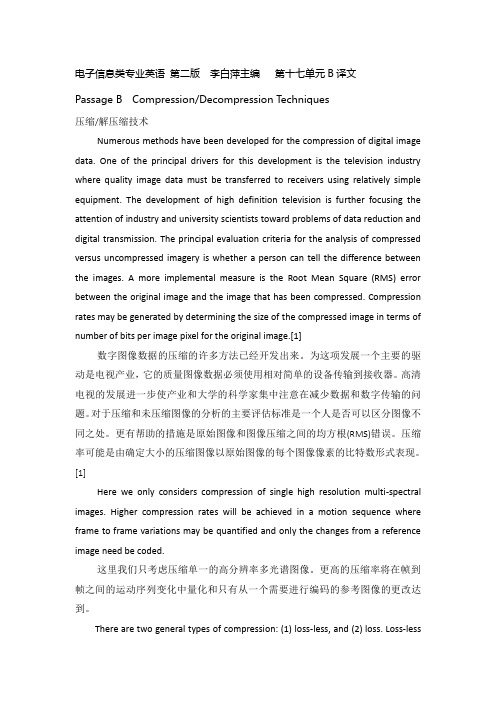
电子信息类专业英语第二版李白萍主编第十七单元B译文Passage B Compression/Decompression Techniques压缩/解压缩技术Numerous methods have been developed for the compression of digital image data. One of the principal drivers for this development is the television industry where quality image data must be transferred to receivers using relatively simple equipment. The development of high definition television is further focusing the attention of industry and university scientists toward problems of data reduction and digital transmission. The principal evaluation criteria for the analysis of compressed versus uncompressed imagery is whether a person can tell the difference between the images. A more implemental measure is the Root Mean Square (RMS) error between the original image and the image that has been compressed. Compression rates may be generated by determining the size of the compressed image in terms of number of bits per image pixel for the original image.[1]数字图像数据的压缩的许多方法已经开发出来。
电子信息专业英语(全套课件154P)

7
1.1. Lesson 1 电子技术发展史
New Words and Technical Terms
astronomically available device benefit radar adv. 天文数字地;天体地 adj. 可得到的;可利用的 n. 器件,设备;部件;组件 vt. 有益于,有助于 n. 雷达,电波探测器 n. 钥匙;解答;关键; 键
1.1. Lesson 1 电子技术发展史
Notes to the Text
Development of Electronics
[1] vacuum tube:真空管是一种电子元件,因为参与工作的电极被封装在一个真空的玻璃容器 内,所以被称为真空管。在中国大陆,真空管有时会被称为电子管。在香港和中国广东地区, 真空管有时又会被称作“胆”。 [2] a sealed glass in which electrons flow between electrodes separated by vacuum:in which关系 代词在定语从句中做介词宾语时,由介词 + 关系代词引导定语从句。separated by vacuum过去 分词修饰electrodes。句子可以翻译为:在密封的玻璃管中,电子在由真空隔离的电极间流动。 [3] it became possible to amplify and transmit the electrical energy:it代替不定式to amplify and transmit the electrical energy在句中作形式主语。句子可以翻译为:放大和传送电能成为可能。 [4] radio communication:无线电通信。
[5] as more specialized tubes were made for many applications:as引导状语从句,句子可以翻译 为:随着越来越多的适用于各种用途的专门真空管制造出来。
电子信息英语重点 李白萍
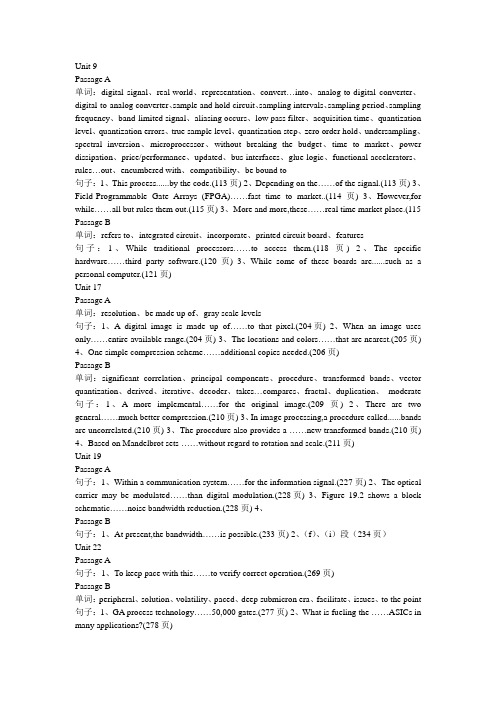
Unit 9Passage A单词:digital signal、real-world、representation、convert…into、analog-to-digital converter、digital-to-analog converter、sample and hold circuit、sampling intervals、sampling period、sampling frequency、band-limited signal、aliasing occurs、low pass filter、acquisition time、quantization level、quantization errors、true sample level、quantization step、zero order hold、undersampling、spectral inversion、microprocessor、without breaking the budget、time to market、power dissipation、price/performance、updated、bus interfaces、glue logic、functional accelerators、rules…out、encumbered with、compatibility、be bound to句子:1、This process......by the code.(113页) 2、Depending on the……of the signal.(113页) 3、Field-Programmable Gate Arrays (FPGA)……fast time to market..(114页) 3、However,for while……all but rules them out.(115页) 3、More and more,these……real time market place.(115 Passage B单词:refers to、integrated circuit、incorporate、printed circuit board、features句子:1、While traditional processors……to access them.(118页) 2、The specific hardware……third party software.(120页) 3、While some of these boards are......such as a personal computer.(121页)Unit 17Passage A单词:resolution、be made up of、gray scale levels句子:1、A digital image is made up of……to that pixel.(204页) 2、When an image uses only……entire available range.(204页) 3、The locations and colors……that are nearest.(205页) 4、One simple compression scheme……additional copies needed.(206页)Passage B单词:significant correlation、principal components、procedure、transformed bands、vector quantization、derived、iterative、decoder、takes…compares、fractal、duplication、moderate 句子:1、A more implemental……for the original image.(209页) 2、There are two general……much better compression.(210页) 3、In image processing,a procedure called......bands are uncorrelated.(210页) 3、The procedure also provides a ……new transformed bands.(210页) 4、Based on Mandelbrot sets ……without regard to rotation and scale.(211页)Unit 19Passage A句子:1、Within a communication system……for the information signal.(227页) 2、The optical carrier may be modulated……than digital modulation.(228页) 3、Figure 19.2 shows a block schematic……noise bandwidth reduction.(228页) 4、Passage B句子:1、At present,the bandwidth……is possible.(233页) 2、(f)、(i)段(234页)Unit 22Passage A句子:1、To keep pace with this……to verify correct operation.(269页)Passage B单词:peripheral、solution、volatility、paced、deep submicron era、facilitate、issues、to the point 句子:1、GA process technology……50,000 gates.(277页) 2、What is fueling the ……ASICs in many applications?(278页)。
电子信息类专业英语(第二版)(李白萍)
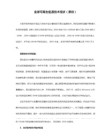
On the contrary,TS-SCDMA adapts the uplink/downlink radio according ro the data load within a single unpaired frequency thus utilizing the spectrum more efficiently,and provides dara rates ranging form 12kbps to 2Mbps.
6.作为一种以同步模式运行的结合CDMA自适应技术的高级TDMA、TDD系统,TD-SCDMA具有对称电路交换服务业务(如语音和视频)和非对称组交换服务业务(如手机上网)。
Designed as an advanced TDMA,TDD system with an adaptive CDMA component operating in synchronous mode,TD-SCDMA masters both symmetric circuits switched services (such as speech or video)as well as asymmetric packet switched services(such mobile internet access).
The signal-processing block at the transmitter conditions the source for more efficient transmission.
5.此外信号处理器还可以给数码子加入奇偶校验位,即提供信道编码 ,使的接收机的信号处理器可以进行误码检测和纠错,以减少或消除由信道噪声所引起的误码。
(完整版)电子信息专业英语复习资料

电子信息专业英语复习资料一、基本术语(英译汉)1.probe探针2.real time operational system 实时操作系统3.debugger 调试器4.sourse code 源代码5.software radio wireless LAN 软件无线电网络6.base station 基站7.top-down approach 自顶向下分析法8.variable 变量9.data compress 数据压缩10.signal conditioning circuit 信号调理电路11.Chebyshev Type Ⅰfilter 切比雪夫Ⅰ型滤波器12.vertical resolution 垂直分辨率13.device driver 设备驱动piler 编译器15.template 模板16.concurrent process 并发进程17.object recognition 目标识别18.Discrete Time Fourier Transform 离散傅立叶变换bined circuit 组合逻辑电路20.impedance transform 阻抗变换器21.voltage source 电压源22.passive component 无源器件23.quality factor 品质因数24.unit-impulse response 单位脉冲响应25.noise origin 噪声源26.Domino effect 多米诺效应27.output load 输出负载28.cordless phone 无绳电话29.Antenna 天线30.harmonic interference 谐波干涉31.Parallel Resonant 并联谐振32.voltage control oscillator 压控振荡器33.adaptive delta modulation 自适应增量调制34.amplitude modulation 调幅二、缩略语(写出全称)1.LSI:large scale integration2.PMOS:p-type metal-oxide semiconductor3.CT:cycle threshold4.MRI:magnetic resonance imaging5.ROM:read-only memory6.DRAM:dynamic random access memory7.TCXO:temperature compensated X'tal (crystal) OscillatorB:Universal Serial Bus9.DCT:discrete cosine transform10.DC:direct current11.CD:Compact Disc12.ASIC:application-specific integrated circuit13.MPEG:Moving Picture Experts Group14.ASSP:application-specific standard product15.EEPROM:electrically erasable programmable read-only memory16.GBW:gain band width17.PLD:programmable-logic device18.RTL:resistor transistor logic19.IP:intellectual property20.FPGA:field-programmable gate array21.CAD:computer-aided design22.MAC:multiply-accmulate23.GSM:Global System for Mobile communications24.CDMA:code division multiple access25.EDA:electronic-design automation26.HDL:hardware-description language27.OS:operating system28.PCB:printed-circuit board29.CMOS:complementary metal-oxide semiconductor30.AC:alternating current31.SRAM:static random-access memory32.PLL:phase-locked loop三、翻译(英译汉+汉译英)1.Bode presented a log technique that transformed the intensely mathematical process of calculating a feedback system's stability into graphical analysis that was simple and perceptive.伯德采用的是一种对数方法——将分析反馈系统稳定性的数学过程转换为简单又好理解的图形化分析。
《电子信息工程专业英语》教学大纲-李威震
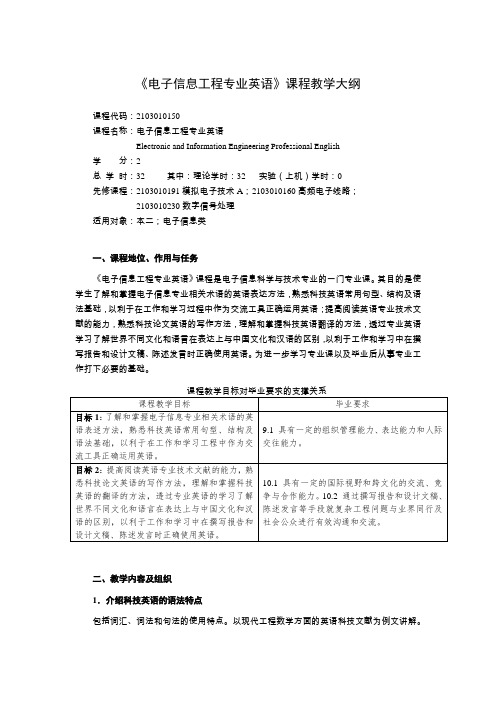
《电子信息工程专业英语》课程教学大纲课程代码:2103010150课程名称:电子信息工程专业英语Electronic and Information Engineering Professional English学分:2总学时:32 其中:理论学时:32 实验(上机)学时:0先修课程:2103010191模拟电子技术A;2103010160高频电子线路;2103010230数字信号处理适用对象:本二;电子信息类一、课程地位、作用与任务《电子信息工程专业英语》课程是电子信息科学与技术专业的一门专业课。
其目的是使学生了解和掌握电子信息专业相关术语的英语表达方法,熟悉科技英语常用句型、结构及语法基础,以利于在工作和学习过程中作为交流工具正确运用英语;提高阅读英语专业技术文献的能力,熟悉科技论文英语的写作方法,理解和掌握科技英语翻译的方法,透过专业英语学习了解世界不同文化和语言在表达上与中国文化和汉语的区别,以利于工作和学习中在撰写报告和设计文稿、陈述发言时正确使用英语。
为进一步学习专业课以及毕业后从事专业工作打下必要的基础。
二、教学内容及组织1.介绍科技英语的语法特点包括词汇、词法和句法的使用特点。
以现代工程数学方面的英语科技文献为例文讲解。
2.科技英语词汇的构成包括派生法、复合法、转化法、拼缀法和缩略法。
以随机变量模拟方面的英语科技文献为例文讲解。
3.科技英语中数量的表示以理想运算放大器方面的英语科技文献为例文讲解3.1数字的表示3.2不确定数字的表示3.3习惯短语3.4 倍数增减4.常用介词及其用法以信号,线性系统和卷积方面的英语科技文献为例文讲解4.1介词与动词、名词和形容词的搭配4.2常用短语介词4.3常用介词的特殊用法5.科技英语中“As”的用法以无线电和微波应用相关英文文献作为例文。
5.1用作介词,构成介词短语,在句中作同位语、状语或补足语5.2用作连词引导状语从句5.3用作关系代词或关系副词引导定语从句5.4固定短语结构6.动词非谓语形式包括动名词、现在分词、过去分词和不定式,被动语态的翻译和类型。
电子信息类专业英语(西电第二版)Unit 7 Digital Modulation-精选文档
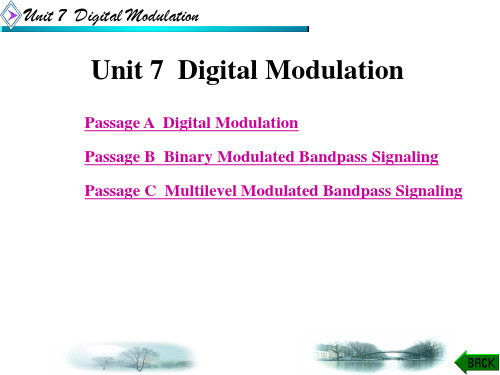
Unit 7 Digital Modulation
Passage A Digital Modulation Passage B Binary Modulated Bandpass Signaling
Passage C Multilevel Modulated Bandpass Signaling
Unit 7 Digital Modulation
In digital communication systems, the modulating signal (e. g., message) may be represented as a time sequence of symbols bits/symbol.[1] or pulses, where each symbol has m finite states. Each symbol repn, where n=log2m Many digital modulation schemes are used in modern
Unit 7 Digital Modulation
New multipurpose programmable digital signal processors have
made it possible to implement digital modulators and
demodulators completely in software. Instead of having a particular modern design permanently frozen as hardware, embedded software implementations now allow alterations and improvements without having to redesign or replace the modem.
电子信息类专业英语李白萍 翻译 Unite5 passageA
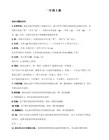
对空间和地球卫星的发展的探索已经增加减少电子电路的尺寸和重量的重要性。另外,即使政治部流动较快的计算机的信号的电子元件之间的互连的时间延迟是一个重要的考虑因素。如果互连减小尺寸,计算机可以以更快的速度进行操作。
2 microelectronics involves the miniaturization of regular electronic circuits . A complete electronic circuit ,an operational amplifier for example ,which contains larger numbers of individual interconnected components , such as diodes resistors, transistors,etc. may be formed on a very small single substrate. the complete miniaturized circuit is then called an integrated circuit
引进于1992年,索尼迷你光碟措施仅6.35厘米(2??.5英寸)的直径,但它可以被用来记录以及播放长达74分钟的音乐。它的小尺寸使得可以通过数据压缩的系统,它利用心理声学原理来消除数据是不正常的牛群被监听器有通过降低数据密度的五分之一,需要对传统的CDs.Mini,光盘只能用于自己的录放机。
u5
passage A
CD and CD-ROM
CD和CD-ROM
1
a compact disc(CD) is a laser-read (also termed "optically read") data storage device on which audio,video,or textual material can be stored. although ithas been used primarily to record stereophonic sound and has supplanted the long-playing PHONOGRAPH record as the principal medium for music storage of massive amounts of many types of information .
电子信息类专业英语(第三版)李白萍章 (8)

Unit8 Electromagnetic Field and Wave
Prior to undertaking the study of electromagnetic fields , we must define the concept ofafield. When we define the behavior of a quantity in a given region in terms of a set of values , one for each point in that region , we refer to this behavior of the quantity as field.[ 1 ] The value at each point of afield can either be measured experimentally or predicted by carrying our certain mathematical operations on some other quantities.
Unit8 Electromagnetic Field and Wave
In the case of conductors , the effect of conduction is to produce a current in the material known as the conduction current. Conduction is the phenomenon whereby the free electrons inside the material move under the influence of the externally applied electric field with an average velocity proportional in magnitude to the applied electric field , instead of accelerating , due to the frictional mechanism provided by collisions with the tomic lattice.
电子信息类专业英语科技作文模板

电子信息类专业英语科技作文模板Captivating the future with the pulse of electronic information technology, the realm of electronic information engineering stands as a beacon of innovation and progress. As we delve into the intricacies of this field, it becomes imperative to articulate our ideas and research in a manner that resonates with the global community of technologists. Here lies a template crafted to empower students and professionals alike to compose compelling English-language scientific essays that not only convey knowledge but also inspire curiosity and collaboration.In the realm of electronic information technology, the quest for knowledge is an unending journey. It is a fieldthat thrives on the synergy of innovation and practical application, where each discovery paves the way for new horizons. As we embark on this voyage of discovery, our essays must reflect the precision and clarity that are the hallmarks of our discipline.Begin with a captivating introduction that sets the stage for your exploration. "In an era where digital signals shape our reality, the electronic information technology sector is at the forefront of transforming the world we live in." This opening line invites the reader to join you in your intellectual expedition.Proceed to the body of your essay with a structuredapproach. Start by outlining the current state of the field, highlighting the key advancements and their implications. Use statements like, "The advent of nanotechnology has revolutionized the way we design and manufacture electronic components, leading to devices that are more powerful yet incredibly compact."Transition smoothly into the core of your research or topic. Here, you can delve into specific technologies, theories, or applications. For example, "The integration of artificial intelligence with electronic systems has opened up new avenues for automated decision-making processes, enhancing efficiency and accuracy in various industries."Illustrate your points with examples and case studies. This not only strengthens your argument but also provides tangible evidence of the impact of your subject matter. Phrases like, "Consider the recent breakthrough in wireless communication, where the development of 5G technology has exponentially increased data transfer rates, paving the way for smart cities and autonomous vehicles," can be used to make your essay more engaging.Conclude your essay by summarizing the key points and reflecting on the future implications of your subject. A strong conclusion might read, "As we stand on the precipice of a new era in electronic information technology, it is clear that the innovations of today will lay the foundation for a more interconnected and intelligent tomorrow."Remember, the essence of a scientific essay lies in itsability to communicate complex ideas in a manner that is accessible and engaging. Use this template as a guide to craft your own unique narrative, one that not only informs but also ignites the imagination of your audience.。
电子信息类专业英语(第二版) 课件李白萍
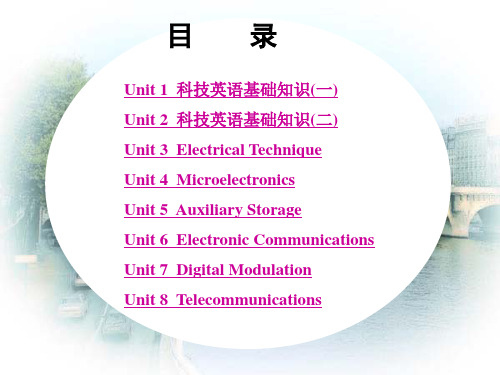
Unit 1 科技英语基础知识(一)
(3) 非谓语动词多。 英语语法有一条特定要求,即在英语的每个简单句中只 能有一个谓语动词,如果读到几个动作,就必须选出主要动 作当谓语,而将其余动作用非谓语动词形式,才能符合英语 语法要求。这就是英语为什么不同于其他语言,有非谓语动 词,而且用得十分频繁的原因。 非谓语动词有三种: 动名词、分词(包括现在分词、过去 分词)和不定式。
Unit 1 科技英语基础知识(一)
(8) 文章结构上,力求层次分明,多用连接词,例如: first,secondly,thirdly,then,thus,therefore,hence, further,furthermore,moreover,besides,in addition, while,meanwhile,in the meantime,at the same time, whereas,also,at last,finally,in conclusion,as a result, consequently,in order to,however,nevertheless, in fact, as a matter of fact,in other words,in a word,summarily, as a rule,generally,generally speaking,broadly speaking, in general (9) 用词较正规,多为技术性用词。
Unit 1 科技英语基础知识(一)
(4) 词性转换多。英语单词有不少是多性词: 既是名词, 又可作动词、形容词、介词等。 例8 above 介词: above all (things) 首先,最重要的是 形容词: for the above reason 由于上述原因 副词: as (has been) indicated above 如上所指出 例9 light 名词: (启发)in (the) light of 由于,根据 (光)high light(s) 强光,精华 (灯)safety light 安全指示灯
- 1、下载文档前请自行甄别文档内容的完整性,平台不提供额外的编辑、内容补充、找答案等附加服务。
- 2、"仅部分预览"的文档,不可在线预览部分如存在完整性等问题,可反馈申请退款(可完整预览的文档不适用该条件!)。
- 3、如文档侵犯您的权益,请联系客服反馈,我们会尽快为您处理(人工客服工作时间:9:00-18:30)。
Unit Seven Images and Televisions
Typical Application areas are: Inspection Verification of assembly, quality control in production, directional guidance systems, face and signature recognition and document processing. Medicine Environment Entertainment broadcast purposes. Tomographic reconstruction, cell recognition, Remote sensing of land use, environment Virtual reality and image compression for automated screening, image-guided surgery and multi-sensor imaging. monitoring and international surveillance.
Unit Seven Images and Televisions Passage A Fundamental Concepts
Computational image processing can be defined as the operation of mathematical functions on numeric representations of pictorial scenes. In general it is part of an overall process of visual perception, pattern recognition and image understanding. These form the essential components of computer vision. Fortunately image processing is conceptually rather simpler than many of the cognitive processes associated with computer vision and has been the subject of rather more practical and successful effort. Whilst it may be of scientific interest to exploit mathematics in the pursuit of perception, the objective basis of image processing is to apply an algorithm to a representation (usually digital) of a visual scene to produce following results.[1] · Understanding through quantitation. · Perception through an improvement in a chosen index of quality. · Efficiency through improved image coding.
Unit Seven Images and Televisions
Image Analysis The goals of image analysis can take a variety of forms: · A complete symbolic description of an image at an adequate level of abstraction. · A list of interesting events, or objects, occurring within the image. · A description of changes which have occurred between successive recordings of an image. The first of these definitions allows us some flexibility in the chosen level of abstraction. In image processing we will normally be operating at the lowest level, which names regions, pixels or lines and attributes characteristics. At higher levels we begin to bring in knowledge of the imaged domain. The general structure of the overall imaging system can be simplified as in Figure 7.1.
Unit Seven Images and Televisions
observed & analysed world scene record preprocess ±features classify hypothesis
samprld
Figure7.1 A general model of image analysis
Unit Seven Images and Televisions
A system for pattern analysis and understanding may require up to seven basic components. · A database which contains the outcomes of capture or processing. · A module containing algorithms and protocols of processing. · A module containing knowledge about the task domain and the candidate nature of the image. · A module containing concepts of control and strategies of processing. · A learning module which enhances knowledge in the task domain by analyzing the effectiveness of current processing strategies. · A module which explains actions and results and allows interrogation. · A user interface enclosing all of the above into a convenient operational entity.
Unit Seven Images and Televisions
Unit Seven Images and Televisions
Passage A Fundamental Concepts Passage B Compression/Decompression Techniques Passage C Television
Unit Seven Images and Televisions
Image Formation Images are formed either by reflection or transmission, in the first case a typical example is an object illuminated by visible light and recorded with a camera. The geometry of the resultant image is governed by the general translation of a 3D object (world coordinates) to a 2D scene (camera coordinates). Transmission images, on the other hand, result from the passage of radiation through an object. The structure of a resultant image depends on the internal properties of the object. A typical example is the normal medical X-ray film, producing an image in two dimensions of electron density integrated along a ray path, thereby discriminating bone from soft tissue. A variant of this, tomographic imaging, produces a cross section (transverse) image and is the result of processing transmission profiles taken at a number of different angles of illumination, which are then built into a three dimensional data space.[2]
Unit Seven Images and Televisions
The images we deal with may be simple, as in a single printed character, or complex as in an aerial photograph or medical image. The two fundamental characteristics of images are their spatial resolution (number of pixels in orthogonal axes) and their intensity resolution (number of bits per pixel). How this digital structure is presented to the observer is a function of the visualization system, not that of the processing system. As an example, a magnetic resonance imaging system might be used to provide data on the movement of the knee joint. Each image plane is collected at a spatial resolution of 256×256 pixels with up to 256 intensity levels. In each data volume there are 128 planes. Eight such data sets are collected, each at a different knee angle. This examination would take up over 67 Mbytes and it needs considerable computing power to do quite simple things with the data in any acceptable time scale.
